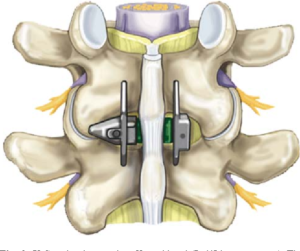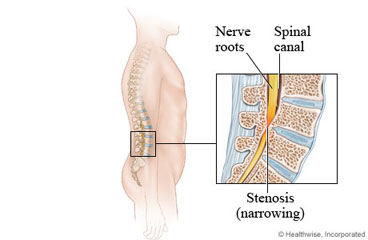Spinal stenosis is a disease which implies the narrowing of the spinal canal in a specific segment. As a result, it diminishes the space available for the spinal cord and root.
In cases of spinal stenosis in which surgery is indicated, the following techniques have proven effective:
The placement of an interspinous device
It consists of placing a small implant between the spinous processes of the vertebrae through a small incision in the patient’s back. Generally, implantation does not require general anaesthesia and can be performed under local anaesthesia. Its goal is to keep the posterior portion of the vertebrae apart and open the spinal canal. Conceptually, it maintains the vertebrae in the posture they are in when the patient is sitting. In fact, this procedure is indicated for patients with spinal stenosis in whom, when sitting or flexing the spine forward, their pain disappears.

How can you know if you can be a candidate?
The placement of an interspinous device requires that the patient meets all these criteria:
-You are 50 years or older and have “neurogenic claudication” (that means pain in the legs that only appears when walking and disappears when sitting or flexing the spine forward).
-You can walk 50 meters or more.
-You have no motor deficit.
-You have no “spondylolisthesis,” or the one he has is grade I (and no more),
-Stenosis affects only 1 or 2 vertebral levels.
If the patient does not meet these characteristics or an interspinous device has been previously implanted and has not been effective, and if the general condition of the patient allows it, it is advisable to evaluate the classic surgery. It consists of decompressing the nerve root by performing a laminectomy.
Only in very specific cases (typically, when the stenosis is due to important and progressive “spondylolisthesis”) does it make sense to consider, in addition, fix the vertebrae (“arthrodesis”). This fixation can be done with a bone graft which is artificial or the patient’s own, or by adding, in addition, mechanical devices such as plates and screws, boxes, etc. Studies show that the simpler the surgical technique, the safer it is and the better the results.
About the surgery
The surgery is relatively aggressive, requires general anaesthesia and involves considerable bleeding. However, when the cases in which it is operated are carefully selected, it is relatively safe and its mortality is 0.5%.
In the case of patients in whom an interspinous device is indicated, the latest studies show that the clinical results obtained by this technique, laminectomy and arthrodesis are similar, after 1 and 2 years, in terms of pain improvement, disability, psychological involvement and patient satisfaction.
The placement of an interspinous device is less aggressive than traditional surgery, has minor surgical complications, leads to less blood loss and duration of the operation, and shortens the hospital stay. This means that it can be applied to patients in whom traditional surgery, due to its aggressiveness, is impossible (for example, due to cardiovascular diseases that discourage prolonged operation).
You might also want to read: What is spinal stenosis?

